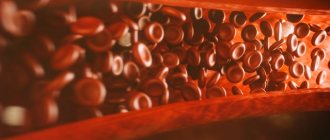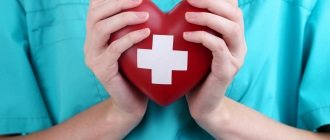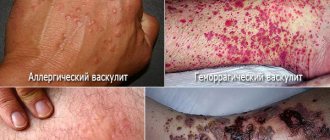Symptoms and forms of coronary heart disease
With coronary heart disease, under the influence of certain factors, the heart muscle stops receiving sufficient blood supply. Myocardial damage occurs, in which the amount of oxygen and nutrients supplied to it decreases. IHD is usually caused by damage to the coronary arteries that carry blood to the heart. Thus, blood vessels stop functioning normally if they become spasmed, become clogged with a blood clot (with increased blood viscosity), or if atherosclerotic (cholesterol) plaques begin to deposit on the walls of the artery.
Clinical forms of ischemic disease:
- Angina pectoris. It is characterized by episodic suffocating and burning pain behind the sternum, which can be felt in the shoulder joint or peritoneal area. Occurs when the myocardium is depleted due to oxygen starvation.
- Myocardial infarction. It occurs when the heart artery is blocked: since the blood stops feeding the heart muscle, partial death of its tissue begins (necrosis).
- Cardiosclerosis. Develops after a myocardial infarction - dead myocardial cells are replaced by connective tissue.
- Arrhythmic variant of ischemic disease. Oxygen starvation of the heart muscle leads to conduction disturbances and, accordingly, pathological changes in heart rhythm.
- Heart failure. Symptoms of oxygen deficiency spread to all tissues of the body, peripheral circulation is disrupted.
- Sudden coronary cardiac arrest. If you do not provide assistance to the victim in a timely manner, it can lead to death.
In the first stages of the disease, a person may not be aware of the health problems that have arisen: the body tries to redistribute the load to other systems, and for some time the symptoms of the disease do not appear.
The first signs of myocardial damage:
- shortness of breath;
- a feeling of interruptions in the work of the heart;
- increase (extremely rare - decrease) in blood pressure.
At a later stage, the above symptoms are accompanied by pain in the sternum or radiating to the neck and shoulder joint.
Did you know that:
- Killer statistics
- What is coronary heart disease
- Main risk factors
- Necessary examination
- Treatment methods for IBM
- When is a cardiologist needed?
- The total length of the vessels is about 120,000 kilometers, i.e. one third of the distance from the Earth to the Moon;
- During one contraction, the heart ejects 60-75 ml. blood, 5 liters of blood per minute, 7200 liters of blood per day, 263 tons per year;
- With an average life expectancy (average 70 years), the heart produces more than 2.5 billion contractions and pumps 184,100 tons of blood.
Primary prevention of coronary heart disease
Measures to prevent previously unoccurring disease are called primary prevention of coronary heart disease . To implement it, pay attention to your lifestyle and eliminate sources of negative changes.
Factors that increase the risk of coronary heart disease
- Genetic predisposition . Think about whether you have relatives who suffer from or have died from cardiovascular diseases.
- Age . Upon reaching 40-50 years of age, take tests and undergo an examination every six months (biochemical indicators, ultrasound of the heart, cardiogram, etc.).
- Floor . Thanks to the influence of estrogen, women are less susceptible to atherosclerosis. After menopause, when hormonal changes occur, the risk of IHD in women increases.
- Accompanying illnesses . For example, people suffering from obesity, atherosclerosis, arterial hypertension or diabetes mellitus are likely to have problems with the cardiovascular system. Therefore, it is imperative to correct the existing pathological conditions.
- Bad habits . Smoking, consumption of alcoholic beverages, and a tendency to overeat affect appearance, well-being and undermine the functioning of internal organs.
- Insufficient physical activity or excessive physical activity . Both physical inactivity and unhealthy passion for sports wear out the body. Give preference to moderate cardio exercises - cycling, brisk walking, volleyball. Exercise three times a week for 30-40 minutes.
- Hyperresponsibility and constant stress . Contact a psychotherapist or get acquainted with modern relaxation methods to improve adaptation to stress (meditation, self-massage, keeping a personal diary).
Types of prevention of coronary heart disease
Prevention of IHD is expressed in two ways: primary and secondary prevention of IHD. In the first case, preventive measures are aimed at eliminating the possibility of the occurrence of a disease such as coronary artery disease.
In the second case, preventive measures are aimed at avoiding exacerbation of an already formed disease.
This means that primary prevention of CHD is carried out by people who do not have coronary heart disease, and secondary prevention concerns those who already suffer from CHD.
Treatment and secondary prevention of coronary heart disease
If, at an appointment with a cardiologist, problems with the nutrition of the heart muscle were diagnosed or the patient suffered one of the clinical forms of the disease, secondary prevention of coronary heart disease is prescribed. Pharmaceuticals, physiotherapy, traditional methods come to the rescue, and in difficult cases, surgical intervention (coronary angioplasty, coronary artery bypass grafting).
Medicines for the prevention and treatment of ischemic heart disease
With the help of medicinal substances, it is necessary to slow down or, if possible, eliminate the process of thrombosis and the deposition of atherosclerotic plaques. Metabolic processes in the myocardium should also be restored. Additionally, it is worth prescribing medications to normalize heart rate and blood pressure. For this purpose, the following groups of drugs are used:
| Group of drugs | Representatives and dosage | Purpose | Contraindications |
| Anticoagulants | Acetylsalicylic acid – 250 mg, warfarin – 5 mg 2 times / day; Ticlopidine – 0.25 g twice a day, clopidogrel – 75 mg. | Makes blood more viscous and prevents blood clots | Peptic ulcers of the gastrointestinal tract, liver failure, blood clotting disorders |
| Lipid-lowering drugs | Statins: lovastatin - 80 mg, atorvastatin - 10 mg, fluvastatin - 40 mg twice a day. | Eliminate atherosclerotic plaques and prevent their occurrence | Liver and kidney disorders, diabetes mellitus, osteoporosis |
| Fibrates: clofibrate – 5 g up to 4 times a day, fenofibrate – 145 mg. | |||
| Others: cholestyramine – 4 g up to 4 times a day; nicotinic acid – up to 0.5 g per day. | |||
| ß-blockers and other antiarrhythmic drugs | Carvedilol – up to 25 mg per day. | Normalizes cardiac conduction | Bronchial asthma, bradycardia, hypotension |
| Amiodarone – 200 mg three times a day. | |||
| ACE inhibitors, angiotensin receptor blockers | Captopril – 100-150 mg, cilazapril – 500 mg. | Normalize blood pressure | Disorders of the excretory system, pulmonary diseases |
| Losartan – 50 mg. | |||
| Agents that restore metabolism in the heart muscle | Trimetazidine – 70 mg, levocarnitine – up to 1 g, creatine phosphate – 1-2 g, mildronate – 500 mg. | Restore myocardial nutrition | Renal or liver failure, hypersensitivity to drugs |
| Nitrates | Nitroglycerin - ½ or 1 tablet. under the tongue as a first aid remedy for an attack of angina pectoris | Dilate coronary vessels | Cerebral hemorrhage, hypotension, glaucoma |
| Diuretics | Hypothiazide - 25 mg per day. | Relieves swelling caused by impaired microcirculation in the extremities | Hypokalemia, renal failure |
Note! The article provides approximate dosages for reference! Women during pregnancy must coordinate the use of any medication with their doctor!
Physiotherapy methods
These methods of preventing coronary heart disease are used according to doctor’s indications and only in combination with drug therapy.
- shock wave therapy;
- enhanced external counterpulsation;
- stem cell treatment;
- quantum (laser) therapy.
The procedures are aimed at stimulating the regeneration of cardiomyocytes.
Traditional methods of preventing coronary heart disease
With the help of traditional medicine recipes and herbal remedies, you can correct the patient’s condition in the initial stages of coronary artery disease, but in case of serious disorders you should not count on a complete cure.
Hawthorn fruits
Use infusion and tincture:
- To prepare the infusion 1 tbsp. l. raw materials are poured into a glass of hot water and left in a thermos for two hours. Take 1-2 tbsp of strained liquid. l. before meals.
- Alcohol tincture is used 30-40 drops per glass of water up to 4 times a day.
Motherwort grass
Pour 15 g of motherwort herb with a glass of boiling water and let it brew until cool. Drink 1/3 glass before meals 3 times a day. You can use a ready-made tincture - dilute 30-50 drops in 1/2 glass of water and drink 3-4 times a day.
Horseradish with honey
Grind the horseradish root in a blender and mix with honey in equal proportions. Eat 1 tsp daily. remedies with water.
Garlic tincture
A medium head of garlic (up to 50 g) is crushed and infused in 200 g of vodka. Use three times a day, diluting 8 drops of tincture with cool water.
Note! Horseradish and garlic should be used with caution in patients with gastrointestinal diseases (gastritis, mucosal ulcers).
Royal jelly and pollen
Take 5-10 g before meals twice a day.
Statistics
- Of the total number of people dying from myocardial infarction, 30-40% of patients die in the first 15 minutes after the onset of the disease and approximately the same number in the next 2 hours;
- Every day in the Russian Federation, from 9 to 25 emergency medical calls for acute and myocardial infarction are registered. Currently, myocardial infarction accounts for 40% of deaths in the country;
- Every fourth man in Russia at the age of 40 and every third woman after menopause suffers from some kind of cardiovascular disease;
- At the same time, the number of patients who suffered a heart attack is 2.5 million, i.e. almost two percent of the country's total population.
Reminder for the prevention of coronary heart disease
- Include foods containing omega-3 unsaturated fatty acids (nuts, fish, olive oil) and potassium (baked potatoes, dried apricots) in your diet. Limit dishes made from offal and fatty meats, and reduce butter consumption.
- Take vitamin complexes and supplements. Complexes containing omega-3, omega-6 and omega-9 are especially useful.
- Give up bad habits.
- Maintain a sleep-wake schedule.
- During the period of remission, gradually include physical exercises in your daily routine to improve microcirculation in the myocardium.
IHD is a chronic disease that can progress with the wrong lifestyle. Therefore, take care of your health before alarming symptoms appear and take time to prevent ischemia.
4953 Tatyana Kuritskaya 02/27/2018











